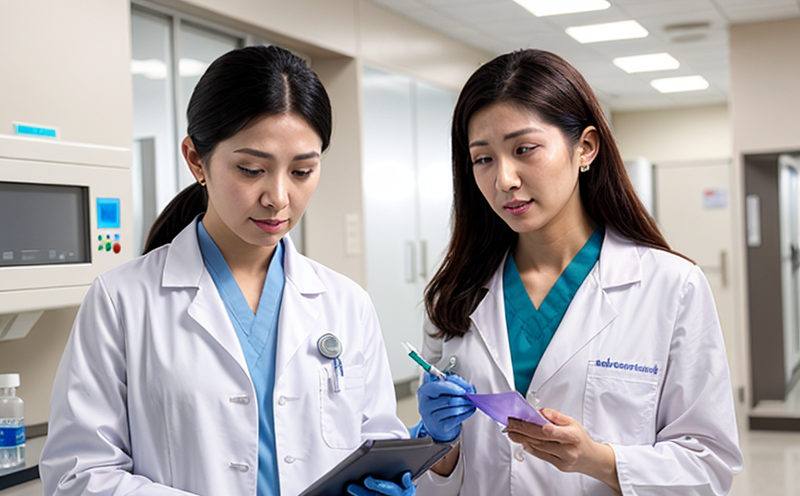ISO 11135 Ethylene Oxide Sterilization Testing for Biologics
The ISO 11135 standard is an internationally recognized protocol that provides a robust framework for the sterilization of medical devices and biologics using ethylene oxide (EO). This method is particularly important in ensuring that products remain sterile without compromising their integrity or efficacy. In pharmaceutical testing, especially for biopharmaceuticals and biosimilars, this process plays a critical role in safeguarding patient health.
The process of sterilization with EO involves exposing the product to EO gas under controlled conditions. The gas penetrates into packaging and internal components, effectively killing microorganisms. However, given the delicate nature of biopharmaceuticals, it is crucial that this method does not alter the chemical composition or stability of the product.
The ISO 11135 standard outlines stringent requirements to ensure that sterilization processes are effective while minimizing any adverse effects on the product. Compliance with these standards ensures that products meet regulatory and quality benchmarks set by agencies such as the FDA, EMA, and WHO.
For biologics, which include vaccines, monoclonal antibodies, and other complex therapeutic proteins, it is essential to maintain their structural integrity post-sterilization. The standard specifies parameters for temperature, humidity, EO gas concentration, and exposure time that must be adhered to rigorously. These conditions are critical in ensuring that the product remains stable and effective.
The testing process involves several key steps:
- Initial microbiological evaluation of the biologic before sterilization
- Exposure to ethylene oxide under controlled conditions
- Monitoring of EO gas concentration during exposure
- Post-sterilization stability testing
- Microbiological evaluation post-sterilization to confirm efficacy of the process
- Documentation and reporting of all test parameters and results
The testing ensures that any residual EO is below the limits set by regulatory bodies, thereby making the product safe for use. This method is particularly important in high-risk applications where sterility is paramount.
In addition to ensuring sterility, compliance with ISO 11135 helps pharmaceutical companies maintain consistency and reliability across production batches. This standardization is crucial for both quality assurance and regulatory compliance.
The rigorous testing process outlined by the ISO 11135 standard ensures that biologics are safe, effective, and of high quality. It also provides a benchmark against which other sterilization methods can be compared. By adhering to this protocol, manufacturers can ensure that their products meet the highest standards of safety and efficacy.
In summary, ISO 11135 is an essential standard for ensuring the safe and effective sterilization of biologics using ethylene oxide. Its stringent requirements guarantee that the process does not compromise the integrity or stability of the product, making it a critical tool in pharmaceutical testing.
Benefits
Ensures compliance with international standards for biologic sterilization
Guarantees sterility of the product without compromising its integrity or stability
Facilitates regulatory approval by meeting stringent quality and safety benchmarks
Reduces risk of contamination, enhancing patient safety
Maintains consistency across production batches for reliability
Simplifies compliance with FDA, EMA, and WHO regulations
Provides a robust framework for testing and validation
Ensures long-term stability of the biologic product
The benefits of adhering to ISO 11135 are manifold. Not only does it ensure that products meet regulatory requirements, but it also enhances patient safety and product reliability.
Industry Applications
The application of ISO 11135 sterilization testing extends across various sectors within the pharmaceutical industry. Biologics like monoclonal antibodies, vaccines, and therapeutic proteins are particularly sensitive to the sterilization process, making this standard crucial for their safe use.
In addition to biopharmaceuticals, other products that benefit from this method include:
- Medical devices
- Laboratory reagents
- Vaccines
- Therapeutic proteins
The versatility of the ISO 11135 standard allows it to be applied in a wide range of contexts, ensuring that sterilization processes are effective and reliable across various pharmaceutical products.
Quality and Reliability Assurance
The ISO 11135 standard is designed to provide a high level of quality and reliability in the sterilization process. By adhering to this protocol, manufacturers can ensure that their products are safe, effective, and consistent across all batches.
The stringent requirements outlined by the standard help to minimize risks associated with contamination and ensure that the product remains stable and efficacious post-sterilization. This is particularly important in high-risk applications where sterility is paramount.
Compliance with ISO 11135 also facilitates regulatory approval, ensuring that products meet the highest standards of safety and efficacy. By adhering to this protocol, manufacturers can ensure that their products are safe for use and reliable across all batches.
The standard provides a robust framework for testing and validation, allowing manufacturers to monitor and control the sterilization process in real-time. This ensures that any issues are identified and addressed promptly, maintaining product integrity and efficacy.
In summary, ISO 11135 is an essential tool for ensuring quality and reliability in biologic sterilization processes. Its stringent requirements guarantee that the process does not compromise the integrity or stability of the product, making it a critical tool in pharmaceutical testing.





